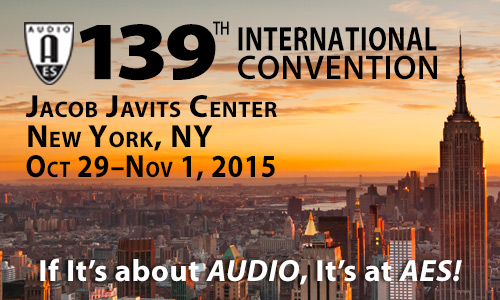
AES New York 2015
Paper Session P4
Thursday, October 29, 2:30 pm — 5:30 pm (Room 1A08)
Paper Session: P4 - Transducers—Part 1: Headphones, Amplifiers, and Microphones
Chair:
Christopher Struck, CJS Labs - San Francisco, CA, USA; Acoustical Society of America
P4-1 Headphone Response: Target Equalization Trade-offs and Limitations—Christopher Struck, CJS Labs - San Francisco, CA, USA; Acoustical Society of America; Steve Temme, Listen, Inc. - Boston, MA, USA
The effects of headphone response and equalization are examined with respect to the influence on perceived sound quality. Free field, diffuse field, and hybrid real sound field targets are shown and objective response data for a number of commercially available headphones are studied and compared. Irregular responses are examined to determine the source of response anomalies, whether these can successfully be equalized and what the limitations are. The goal is to develop a robust process for evaluating and appropriately equalizing headphone responses to a psychoacoustically valid target and to understand the constraints.
Convention Paper 9374 (Purchase now)
P4-2 A Headphone Measurement System Covers both Audible Frequency and beyond 20 kHz—Naotaka Tsunoda, Sony Corporation - Shinagawa-ku, Tokyo, Japan; Takeshi Hara, Sony Corporation - Tokyo, Japan; Koji Nageno, Sony Corporation - Tokyo, Japan
New headphone measurement system consisting of a 1/8” microphone and newly developed HATS (Head And Torso Simulator) with a coupler that have realistic ear canal shape is proposed to enable entire frequency response measurement from audible frequency and higher frequency area up to 140 kHz. At the same time a new frequency response evaluation scheme based on HRTF correction is proposed. Measurement results obtained by this scheme enables much better understanding by enabling direct comparison with free field loudspeaker frequency response.
Convention Paper 9375 (Purchase now)
P4-3 Measurements of Acoustical Speaker Loading Impedance in Headphones and Loudspeakers—Jason McIntosh, McIntosh Applied Engineering - Eden Prairie, MN, USA
The acoustical design of two circumaural headphones and a desktop computer speaker have been studied by measuring the acoustical impedance of the various components in their design. The impedances were then used to build an equivalent circuit model for the devices that then predicted their pressure response. There was seen to be good correlation between the model and measurements. The impedance provides unique insight into the acoustic design that is not observed though electrical impedance or pressure response measurements that are commonly relied upon when designing such devices. By building models for each impedance structure, it is possible to obtain an accurate model of the whole system where the effects of each component upon the device's overall performance can be seen.
Convention Paper 9376 (Purchase now)
P4-4 Efficiency Investigation of Switch-Mode Power Audio Amplifiers Driving Low Impedance Transducers—Niels Elkjær Iversen, Technical University of Denmark - Lyngby, Denmark; Henrik Schneider, Technical University of Denmark - Kgs. Lyngby, Denmark; Arnold Knott, Technical University of Denmark - Kgs. Lyngby, Denmark; Michael A. E. Andersen, Technical University of Denmark - Kgs. Lyngby, Denmark
The typical nominal resistance span of an electro dynamic transducer is 4 Ohms to 8 Ohms. This work examines the possibility of driving a transducer with a much lower impedance to enable the amplifier and loudspeaker to be directly driven by a low voltage source such as a battery. A method for estimating the amplifier rail voltage requirement as a function of the voice coil nominal resistance is presented. The method is based on a crest factor analysis of music signals and estimation of the electrical power requirement from a specific target of the sound pressure level. Experimental measurements confirm a huge performance leap in terms of efficiency compared to a conventional battery-driven sound system. Future optimization of low voltage, high current amplifiers for low impedance loudspeaker drivers are discussed.
Convention Paper 9377 (Purchase now)
P4-5 Self-Oscillating 150 W Switch-Mode Amplifier Equipped with eGaN-FETs—Martijn Duraij, Technical University of Denmark - Lyngby, Denmark; Niels Elkjær Iversen, Technical University of Denmark - Lyngby, Denmark; Lars Press Petersen, Technical University of Denmark - Kgs. Lyngby, Denmark; Patrik Boström, Bolecano Holding AB - Helsingborg, Sweden
Where high-frequency clocked system switch-mode audio power amplifiers equipped with eGaN-FETs have been introduced in the past years, a novel self-oscillating eGaN-FET equipped amplifier is presented. A 150 Wrms amplifier has been built and tested with regard to performance and efficiency with an idle switching frequency of 2 MHz. The amplifier consists of a power-stage module with a self-oscillating loop and an error-reducing global loop. It was found that an eGaN-FET based amplifier shows promising potential for building high power density audio amplifiers with excellent audio performance. However care must be taken of the effects caused by a higher switching frequency.
Convention Paper 9378 (Purchase now)
P4-6 Wind Noise Measurements and Characterization Around Small Microphone Ports—Jason McIntosh, Starkey Hearing Technologies - Eden Prairie, MN, USA; Sourav Bhunia, Starkey Hearing Technologies - Eden Prairie, MN, USA
The physical origins of microphone wind noise is discussed and measured. The measured noise levels are shown to correlate well to theoretical estimates of non-propagating local fluid dynamic turbulence pressure variations called “convective pressure.” The free stream convective pressure fluctuations may already be present in a flow independent of its interactions with a device housing a microphone. Consequently, wind noise testing should be made in turbulent air flows rather than laminar. A metric based on the Speech Intelligibility Index (SII) is proposed for characterizing wind noise effects for devices primarily designed to work with speech signals, making it possible to evaluate nonlinear processing effects on reducing wind noise on microphones.
Convention Paper 9379 (Purchase now)
